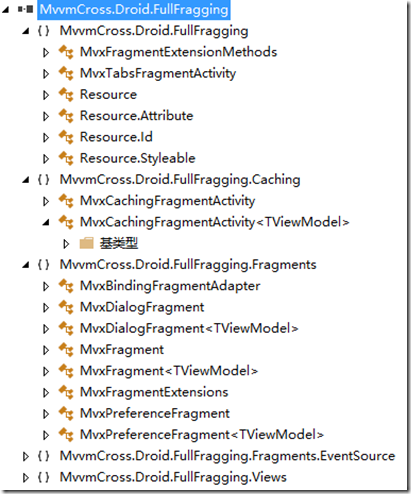前言
上一节我们讲解了在Android平台如何通过MvvmCross实现启动界面,以及如何处理启动时的白屏问题。
这一节我们讲解一下如何在Android平台使用Fragment。
Fragment 应用
什么是Fragment
Fragment是Android开发常用的一种组件。通过Fragment的使用可以降低内存的使用,增加App的流畅度。已经有很多大神讲解过Fragment的内容了,请看这里。
MvvmCross中与Fragment相关的对象
在MvvmCross中,已经实现了很多与Fragment相关的对象,极大的方便我们的使用。
首先我们需要通过nuget 添加MvvmCross对Fragment的支持库 MvvmCross.Droid.FullFragging。现在我们来看一下MvvmCross为我们实现了哪些相关的对象。
这里我们会使用以下几个MvvmCross定义的几个对象:
- MvxFragment: Fragment对象的基类,所有基于MvvvmCross实现的Fragment都需要从此对象继承。

namespace MvvmCross.Droid.FullFragging.Fragments { [Register("mvvmcross.droid.fullfragging.fragments.MvxFragment")] public class MvxFragment : MvxEventSourceFragment, IMvxFragmentView, IMvxBindingContextOwner, IMvxView, IMvxDataConsumer { protected MvxFragment(); protected MvxFragment(IntPtr javaReference, JniHandleOwnership transfer); public IMvxBindingContext BindingContext { get; set; } public object DataContext { get; set; } public string UniqueImmutableCacheTag { get; } public virtual IMvxViewModel ViewModel { get; set; } public static MvxFragment NewInstance(Bundle bundle); public virtual void OnViewModelSet(); } }
- MvxFragmentAttribute,Fragment特性标签,标识了当前Fragment的嵌入的宿主以及显示时后些参数

namespace MvvmCross.Droid.Shared.Attributes { [AttributeUsage(AttributeTargets.Class, AllowMultiple = true)] public class MvxFragmentAttribute : Attribute { public MvxFragmentAttribute(Type parentActivityViewModelType, int fragmentContentId, bool addToBackStack = false); public bool AddToBackStack { get; set; } public int FragmentContentId { get; } public bool IsCacheableFragment { get; set; } public Type ParentActivityViewModelType { get; } public Type ViewModelType { get; set; } } }
- MvxCachingFragmentActivity:Fragment的宿主窗口

namespace MvvmCross.Droid.FullFragging.Caching { [Register("mvvmcross.droid.fullfragging.caching.MvxCachingFragmentActivity")] public class MvxCachingFragmentActivity : MvxActivity, IFragmentCacheableActivity, IMvxFragmentHost { public const string ViewModelRequestBundleKey = "__mvxViewModelRequest"; protected MvxCachingFragmentActivity(); protected MvxCachingFragmentActivity(IntPtr javaReference, JniHandleOwnership transfer); public IFragmentCacheConfiguration FragmentCacheConfiguration { get; } public virtual IFragmentCacheConfiguration BuildFragmentCacheConfiguration(); public virtual bool Close(IMvxViewModel viewModel); public override void OnBackPressed(); public virtual void OnBeforeFragmentChanging(IMvxCachedFragmentInfo fragmentInfo, FragmentTransaction transaction); public virtual void OnFragmentChanged(IMvxCachedFragmentInfo fragmentInfo); public virtual void OnFragmentChanging(IMvxCachedFragmentInfo fragmentInfo, FragmentTransaction transaction); public virtual void OnFragmentCreated(IMvxCachedFragmentInfo fragmentInfo, FragmentTransaction transaction); public virtual void OnFragmentPopped(IList<IMvxCachedFragmentInfo> currentFragmentsInfo); public virtual bool Show(MvxViewModelRequest request, Bundle bundle, Type fragmentType, MvxFragmentAttribute fragmentAttribute); protected virtual void CloseFragment(string tag, int contentId); protected virtual string FragmentJavaName(Type fragmentType); protected virtual IEnumerable<Fragment> GetCurrentCacheableFragments(); protected virtual List<IMvxCachedFragmentInfo> GetCurrentCacheableFragmentsInfo(); protected IMvxCachedFragmentInfo GetFragmentInfoByTag(string tag); protected virtual string GetFragmentTag(MvxViewModelRequest request, Bundle bundle, Type fragmentType); protected virtual IMvxCachedFragmentInfo GetLastFragmentInfo(); protected virtual string GetTagFromFragment(Fragment fragment); protected override void OnCreate(Bundle bundle); protected override void OnPostCreate(Bundle savedInstanceState); protected override void OnSaveInstanceState(Bundle outState); protected virtual void ReplaceFragment(FragmentTransaction ft, IMvxCachedFragmentInfo fragInfo); protected virtual FragmentReplaceMode ShouldReplaceCurrentFragment(IMvxCachedFragmentInfo newFragment, IMvxCachedFragmentInfo currentFragment, Bundle replacementBundle); protected virtual void ShowFragment(string tag, int contentId, Bundle bundle, bool forceAddToBackStack = false, bool forceReplaceFragment = false); protected enum FragmentReplaceMode { NoReplace = 0, ReplaceFragment = 1, ReplaceFragmentAndViewModel = 2 } } }
- MvxFragmentsPresenter,实对Fragment对象的显示,内部对象,MvvmCross框架将自动调用

namespace MvvmCross.Droid.Shared.Presenter { public class MvxFragmentsPresenter : MvxAndroidViewPresenter { public const string ViewModelRequestBundleKey = "__mvxViewModelRequest"; protected FragmentHostRegistrationSettings _fragmentHostRegistrationSettings; protected Lazy<IMvxNavigationSerializer> _lazyNavigationSerializerFactory; public MvxFragmentsPresenter(IEnumerable<Assembly> AndroidViewAssemblies); protected IMvxNavigationSerializer Serializer { get; } public sealed override void Close(IMvxViewModel viewModel); public sealed override void Show(MvxViewModelRequest request); public void Show(MvxViewModelRequest request, MvxViewModelRequest fragmentRequest); protected virtual void CloseActivity(IMvxViewModel viewModel); protected virtual void CloseFragment(IMvxViewModel viewModel); protected IMvxFragmentHost GetActualFragmentHost(); protected virtual void ShowActivity(MvxViewModelRequest request, MvxViewModelRequest fragmentRequest = null); protected virtual void ShowFragment(MvxViewModelRequest request); } }
仿微信的首页来一发
好了,对MvvmCross对Fragment的支持对象我们已经介绍完毕,下面我就动手做一个Fragment的示例,我们就仿照微信的主窗口来试一下
- 首先,定义好宿主,我们用上一节使用的Sample,修改一下主窗口的布局,下部为四个导航按钮,其余部分为当前功能模块的显示窗口,功能模块通过Fragment方式进行展示

using Android.App; using Android.OS; using Android.Widget; using MvvmCross.Droid.Views; using MvxSample.ViewModels; namespace MvxSample.Droid.Views { [Activity(Label = "MainView", MainLauncher = false, Theme ="@android:style/Theme.Light.NoTitleBar")] public class MainView : MvvmCross.Droid.FullFragging.Caching.MvxCachingFragmentActivity<MainViewModel> { protected override void OnCreate(Bundle savedInstanceState) { base.OnCreate(savedInstanceState); SetContentView(Resource.Layout.MainPage); var grp = FindViewById<RadioGroup>(Resource.Id.main_rg_toolbar); grp.CheckedChange += (s, e) => { var btn = FindViewById<RadioButton>(e.CheckedId); if (btn.Checked == false) return; if (e.CheckedId == Resource.Id.main_rb_chat) { ViewModel.ShowChat(); } else if (e.CheckedId == Resource.Id.main_rb_friends) { ViewModel.ShowFriends(); } else if (e.CheckedId == Resource.Id.main_rb_extras) { ViewModel.ShowExtras(); } else if (e.CheckedId == Resource.Id.main_rb_my) { ViewModel.ShowMy(); } }; ViewModel.ShowChat(); } } }

<?xml version="1.0" encoding="utf-8"?> <LinearLayout xmlns:android="http://schemas.android.com/apk/res/android" android:layout_width="match_parent" android:layout_height="match_parent" android:orientation="vertical"> <LinearLayout android:id="@+id/main_container" android:layout_width="match_parent" android:layout_weight="10" android:layout_height="match_parent" /> <RadioGroup android:minHeight="50dp" android:layout_width="match_parent" android:layout_height="wrap_content" android:orientation="horizontal" android:layoutMode="clipBounds" android:id="@+id/main_rg_toolbar" android:layout_weight="1"> <RadioButton android:layout_width="match_parent" android:layout_height="wrap_content" android:checked="true" android:text="微信" android:gravity="center" android:layout_weight="1" android:button="@null" android:background="@drawable/radiobtn" android:id="@+id/main_rb_chat" /> <RadioButton android:layout_width="match_parent" android:layout_height="wrap_content" android:text="联系人" android:gravity="center" android:layout_weight="1" android:button="@null" android:background="@drawable/radiobtn" android:id="@+id/main_rb_friends" /> <RadioButton android:layout_width="match_parent" android:layout_height="wrap_content" android:text="发现" android:gravity="center" android:layout_weight="1" android:button="@null" android:background="@drawable/radiobtn" android:id="@+id/main_rb_extras" /> <RadioButton android:layout_width="match_parent" android:layout_height="wrap_content" android:text="我" android:gravity="center" android:layout_weight="1" android:button="@null" android:background="@drawable/radiobtn" android:id="@+id/main_rb_my" /> </RadioGroup> </LinearLayout>
- 下来,我们定义好要展示的Fragment及布局

namespace MvxSample.Droid.Views { [MvxFragment(typeof(MainViewModel), Resource.Id.main_container)] [Register("mvxsample.droid.views.ChatFragment")] public class ChatFragment: MvxFragment<ChatViewModel> { public override View OnCreateView(LayoutInflater inflater, ViewGroup container, Bundle savedInstanceState) { var ignore = base.OnCreateView(inflater, container, savedInstanceState); var view = this.BindingInflate(Resource.Layout.ChatFragment, container, false); return view; } } }

<?xml version="1.0" encoding="utf-8"?> <RelativeLayout xmlns:android="http://schemas.android.com/apk/res/android" android:layout_width="match_parent" android:layout_height="match_parent" android:background="@android:color/holo_purple"> <RelativeLayout android:background="@android:drawable/screen_background_dark_transparent" android:layout_alignParentTop="true" android:layout_height="50dp" android:layout_width="match_parent"> <TextView android:id="@+id/chat_top_title" android:allowUndo="true" android:layout_centerInParent="true" android:layout_width="match_parent" android:layout_height="match_parent" android:text="微信" android:textSize="20dip" android:gravity="center" android:textColor="@android:color/black" /> </RelativeLayout> </RelativeLayout>
按照定义好的ChatFragment,我们定义其它的几个Fragment,分别为FriendsFragment、ExtrasFragment、MyFragment。
- 在Setup重载方法 CreateViewPresenter:

namespace MvxSample.Droid { public class Setup : MvxAndroidSetup { public Setup(Context applicationContext) : base(applicationContext) { } protected override IMvxApplication CreateApp() { return new App(); } protected override IMvxAndroidViewPresenter CreateViewPresenter() { var mvxFragmentsPresenter = new MvxFragmentsPresenter(AndroidViewAssemblies); Mvx.RegisterSingleton<IMvxAndroidViewPresenter>(mvxFragmentsPresenter); return mvxFragmentsPresenter; } } }
- OK,全部代码就完成了,我们运行一下看看效果吧

我们可以看到,根据选中的导航项不时,会展示不同的Fragment的内容。
小结
这一节我们讲解了Framgent在MvvmCross的应用。包括宿主窗口的定义,Fragment的定义以及如何在Setup中使用MvxFragmentPresenter。


